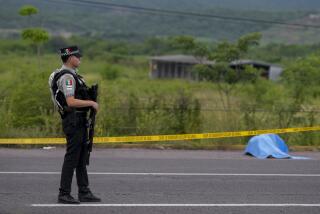Researchers See Another Victim in Cocaine Chain
- Share via
SAN SALVADOR — “Narco-guerrilla” is the term that drew international attention to an obscure conflict that had been fought in Colombia’s jungles for three decades without attracting much notice.
An alliance with drug traffickers in the mid-1990s transformed the Revolutionary Armed Forces of Colombia, or FARC, from an anachronism into a well-equipped Marxist insurgency. It also put the rebels, who “tax” drug crops in areas under their control, at the center of the war on drugs.
Next week, for the first time in 17 months of talks, government and FARC negotiators will discuss the theme behind a $7-billion, internationally financed peace proposal: drug production and the environment.
Potential donors from around the world are expected to gather in a deforested jungle community controlled by the FARC to hear proposals for alternatives to the cocaine production that is devastating Colombia’s slice of the Amazon jungle.
The hearing Thursday and Friday is considered a significant opportunity for the FARC to put its case against drug-crop eradication to world opinion.
Originally scheduled for May, the hearing was postponed because the government suspected the FARC of clasping a necklace bomb on a rancher, who was decapitated in the ensuing blast. A neighbor has since been arrested in the attack, clearing the guerrillas, who had denied responsibility.
That assures the insurgents of the moral authority they need to rail against the fumigation of drug crops, which also wipes out other crops, such as bananas and yucca.
But a group of government-financed researchers may have a surprise for the rebels.
Although the potential donor nations are mainly concerned about the effects of Colombia’s burgeoning cocaine and heroin production on their own populations, the investigators have just finished a three-province study indicating that the most devastating effects of that production may be on the growers of drug crops.
“They are using chemicals with no judgment in terms of their own health,” said Sergio Uribe, who headed the study team. The researchers relied mainly on local residents to gather the information because of resistance to outsiders by armed groups, including the guerrillas, in the drug-producing areas.
Growers of drug crops do not wear gloves or masks when they use toxic pesticides, Uribe said, nor do they have any idea how much of a chemical they need in order to control an infestation.
“There is no agricultural extension service for coca,” he observed.
So growers dump a quart of insecticide per acre every month on their fields, which are often next to the shanties where their families live, the study found.
In one province, Putumayo, researchers found that growers on 100 farms were using 183 kinds of pesticides. Researchers recognized 75 of the pesticides; the rest couldn’t be identified.
Of those 75, 62 are potentially carcinogenic. Growers are also using banned chemicals such as DDT and paraquat, the study found.
Uribe would like to use next week’s hearing to plead for further study on the health of the drug-growing population that would include blood tests for toxin levels and rates of sterility among adults and brain damage among children.
But he said he’s not optimistic that such a study will be conducted--or even that he will be allowed to speak.
“Nobody wants to know anything about this,” he said. “It’s easier to make decisions based on absolute ignorance--they are not interested in the problem because it is not politically sell-able.”
How well it sells will be a significant issue at the gathering, which is expected to lead to a consensus on a European-financed development plan as an alternative or complement to the billion-dollar anti-drug package approved Thursday by the U.S. Senate. That package focuses on crop eradication and military hardware.
The rebels have repeatedly warned that stepping up fumigation of drug crops will only increase the violence of the conflict and cause more environmental damage to the areas where the crops are grown.
But Uribe noted, “You wouldn’t have to spray the coca if it wasn’t there.”
More to Read
Sign up for Essential California
The most important California stories and recommendations in your inbox every morning.
You may occasionally receive promotional content from the Los Angeles Times.










